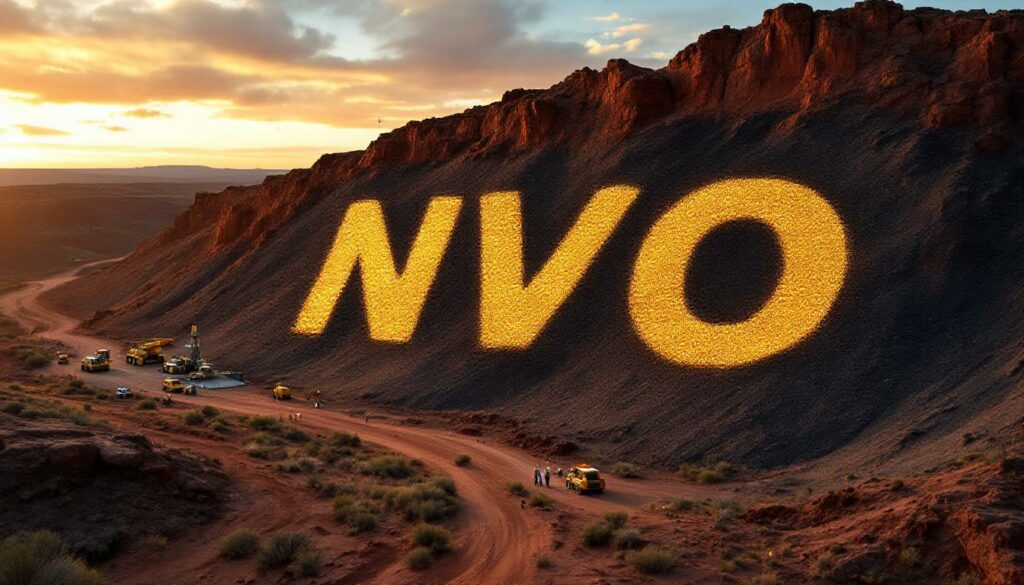Novo Resources Reports Significant High-Grade Gold Results in NSW Drilling Campaign
Novo Resources Corp. (ASX: NVO) has announced promising results from its June 2025 Quarter exploration activities, highlighted by significant high-grade gold intercepts at its Tibooburra Gold Project in New South Wales.
Impressive Gold Intercepts from Maiden Drilling at Tibooburra
Novo's maiden RC drilling program at the Clone prospect within the Tibooburra Gold Project has delivered exceptional results, confirming a significant gold system with outstanding intercepts including:
- 12 meters at 5.90 g/t gold from 16 meters, including 5 meters at 13.74 g/t gold from 23 meters
- 17 meters at 2.40 g/t gold from 59 meters, including 9 meters at 4.14 g/t gold from 59 meters
The program successfully tested 500 meters of strike length and has demonstrated both grade and width continuity, with a shallow north plunge to the near-surface shoot of high-grade gold mineralisation now defined over 300 meters of strike. Importantly, these high-grade intercepts remain open to the north and are being assessed for follow-up drilling.
"These initial drilling results from Tibooburra validate our strategy of acquiring advanced exploration assets with potential for significant gold discoveries. The continuity and grade we're seeing at Clone suggests we've only just begun to unlock the potential of this project." – Mike Spreadborough, Novo's Managing Director
John Bull Gold Project Shows Exceptional Potential
Results from Novo's field campaign at the John Bull Gold Project have confirmed its prospectivity, with four key target areas now identified for drilling in the second half of 2025. Highlights include:
- Extension of a gold anomaly to approximately 1.5 km strike length with peak soil results of 1.59 g/t gold
- Rock chip sampling returning exceptional results of 67.9 g/t gold and 29 g/t gold from sheeted quartz veins in mineralised structural zones
- Strong evidence supporting the presence of an Intrusion Related Gold System (IRGS) model
Understanding Intrusion Related Gold Systems
Intrusion Related Gold Systems (IRGS) are a specific type of gold deposit associated with intrusive igneous rocks, typically granites or other felsic intrusions. These systems are characterised by a zoned distribution of metals, with a core area rich in tin, bismuth, and arsenic, surrounded by intermediate zones containing gold, molybdenum, copper, antimony, and tellurium, with an outer halo of gold, arsenic, antimony, and tungsten.
For investors, IRGS deposits are significant because they often form large, economically viable deposits with predictable geometries. Their characteristic zonation pattern allows explorers to "vector" toward potentially higher-grade areas once part of the system is identified. This model at John Bull provides Novo with clear targets for its upcoming drilling program.
Pilbara Gold and Gold-Antimony Prospects Advancing
Novo continues to advance several high-potential targets in Western Australia's Pilbara region:
- At Sherlock Crossing, exploration has defined a coherent 1.5 km antimony in soil anomaly with gold values up to 85 ppb gold
- Previous targeted rock chip sampling at Sherlock yielded grades of up to 4.7% antimony and 146.7 g/t gold
- The Southeast Wyloo Au-Sb-Ag-Cu Project is being prepared for drill program planning
- Reconnaissance aircore drilling at Balla Balla has delineated broad zones of low-level gold anomalism along the Sholl Shear
Strong Financial Position
Novo maintains a robust financial foundation with:
- Cash balance of A$7 million (C$6 million) as of June 30, 2025
- Investment portfolio valued at approximately A$34 million (C$30 million)
This strong financial position allows Novo to continue aggressive gold exploration by Novo Resources Corp Chess Depositary Interests 1:1 across its portfolio without immediate capital raising concerns.
Future Catalysts and Upcoming Programs
Investors should watch for several potential catalysts in the coming months:
-
Tibooburra Gold Project – Follow-up RC drilling at Clone to test the northern extension of the high-grade shoot
-
John Bull Gold Project – A 1,750-meter RC drill program testing four key target areas in H2 2025
-
Sherlock Crossing – Maiden RC drilling program to test promising gold and antimony mineralisation
-
Southeast Wyloo – RC drill program planned for H2 2025
Why Investors Should Track Novo Resources
Novo Resources represents a compelling investment opportunity in the gold exploration sector for several key reasons:
-
Diversified Portfolio – The company has strategically built a diversified exploration portfolio across leading mining provinces in Australia, reducing geographic risk
-
High-Grade Results – Recent drilling has demonstrated significant high-grade gold intercepts, particularly at Tibooburra
-
Multiple Exploration Catalysts – With several drilling programs planned across multiple projects in H2 2025, there's potential for numerous market-moving discoveries
-
Strong Financial Position – With A$41 million in cash and investments, Novo is well-funded to execute its gold exploration by Novo Resources Corp Chess Depositary Interests 1:1 strategy
-
Strategic Partnerships – The company has formed valuable partnerships, including with Northern Star Resources at the Egina Farm-in/Joint Venture
For investors seeking exposure to gold exploration with near-term catalysts, Novo's combination of high-grade results, multiple drill-ready targets, and strong financial backing positions it as a noteworthy opportunity in the junior mining sector.
Ready to Capitalise on Novo's Gold Exploration Success?
Discover why Novo Resources' high-grade gold intercepts at Tibooburra and exceptional results across its diverse portfolio could represent a significant investment opportunity. With a strong financial position of A$41 million in cash and investments, plus multiple near-term drilling catalysts across several promising projects, now is the time to evaluate Novo's potential in your investment strategy. Visit the Novo Resources website to access detailed investor information, exploration updates and learn more about their strategic approach to gold exploration across Australia's premier mining provinces.




